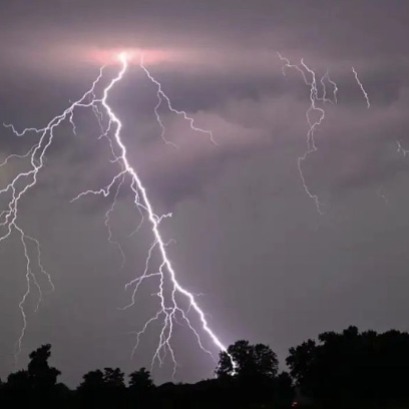
320 million trees die every year due to ray fall
Researchers from the Technical University of Munich (TUM) have developed new calculation models that, for the first time, estimate the global influence of rays in forest ecosystems.
According to its findings, published in Global Change Biology, it is estimated that 320 million trees die each year due to the fall of rays.Tree losses caused by forest fires caused directly by rays are not included in these figures. In the future, the mortality of light -induced trees could increase due to the increase in the frequency of flashes.Damage caused by rays in forests are usually difficult to detect and have only been systematically studied in a few places. Until now, it was not known with certainty how many trees die every year around the world due to direct damage to rays. The TUM research team has developed the first method to estimate how many trees are so severely affected by rays that finally die. Its conclusion: the ecological impact of the rays has underestimated.While the previous studies focused on field observations in individual forests, TUM researchers adopted a mathematical approach. They expanded a widely used global vegetation model by integrating observational data and global patterns of rays.Now we can not only estimate how many trees die annually by rays, but also to identify the most affected regions and evaluate the implications for global carbon storage and forest structure, explains in a statement Andreas Krause, principal author of the study and researcher of the chair of interactions Earth-Atmosphere surface.The 320 million victims every year of the rays represent between 2.1 % and 2.9 % of the total annual plant biomass loss. It is estimated that this biomass decomposition issues between 770 and 1,090 million tons of CO2 per year.The researchers emphasize that these emissions are surprisingly high: their magnitude is comparable to that of approximately 1,260 million tons of CO2 that are released annually due to the combustion of live plants in forest fires. However, total CO2 emissions of forest fires are substantially higher (around 5,850 million tons per year), since they also include the burning of dead wood and organic matter of the soil. More in the futureThe 320 million victims every year of the rays represent between 2.1 % and 2.9 % of the total annual plant biomass loss. It is estimated that this biomass decomposition issues between 770 and 1,090 million tons of CO2 per year.The researchers emphasize that these emissions are surprisingly high: their magnitude is comparable to that of approximately 1,260 million tons of CO2 that are released annually due to the combustion of live plants in forest fires. However, total CO2 emissions of forest fires are substantially higher (around 5,850 million tons per year), since they also include the burning of dead wood and organic matter of the soil. Most climatic models project an increase in rays frequency in the coming decades, so it is convenient to pay more attention to this disturbance, largely ignored, says Krause.Currently, the mortality of ray -induced trees is greater in tropical regions. However, the models suggest that the ray frequency will increase mainly in the regions of medium and high latitudes, which means that ray mortality could also charge greater relevance in temperate and boreal forests.
IT MAY INTEREST YOU
 The second largest wetland in South America is located in Argentina: what is it?
The second largest wetland in South America is located in Argentina: what is it?
Argentina has national parks that place it in a unique position within South America, competing with 300 others. Which is the largest? South America is home to more than 300 national parks, but many go unnoticed. There are extensive wetlands that have been the subject of major ecological restoration projects, to coastal mountains with deep indigenous heritage. Today we tell you the case of one located in Argentina.
 Experts cant believe it, but this tree is the oldest in the world and continues to bear fruit: it is 4,000 years old.
Experts cant believe it, but this tree is the oldest in the world and continues to bear fruit: it is 4,000 years old.
Nature keeps secrets that defy the passage of time, and one of the most surprising examples is a tree that, approximately 4,000 years old, continues to bear fruit today. This specimen has become a symbol of resistance and longevity, capable of surviving climate changes, landscape transformations and human activity itself.
 They promote research in pine resins from the NEA
They promote research in pine resins from the NEA
The forestry industry is one of the most important sectors in the economies of Misiones and Corrientes. Thousands of hectares of pine supply the paper, pulp, boards and sawmill industry. Pinus elliottii, one of the species established in the region, in addition to providing wood, is used to produce resin, a non-wood forest product with high demand in the chemical, pharmaceutical and cosmetic industries. In 2\024, resin extraction of approximately 52,6\0\0 tons was achieved from approximately 18,\0\0\0,\0\0\0 trees in production, generating income and jobs with high expansion potential.





















